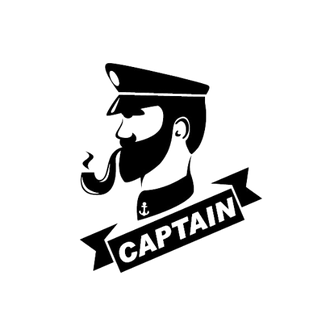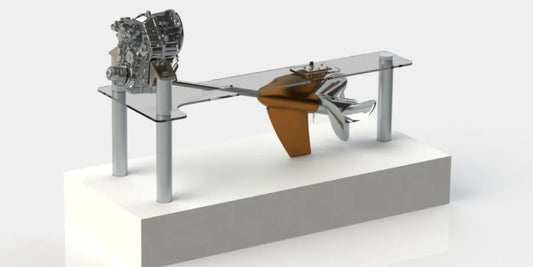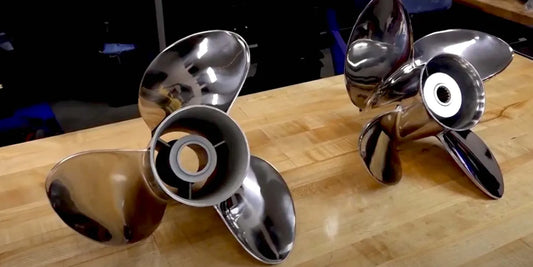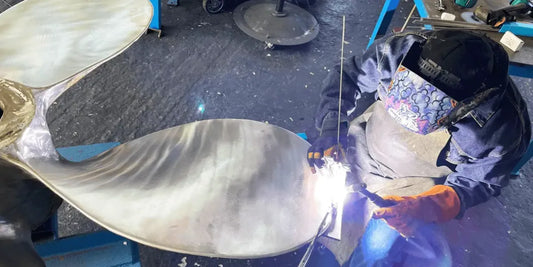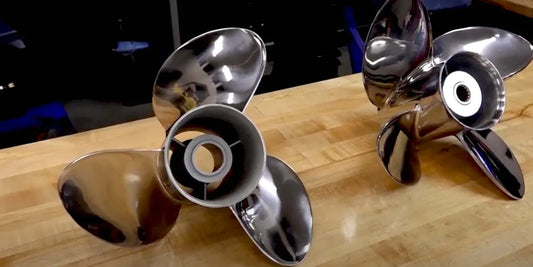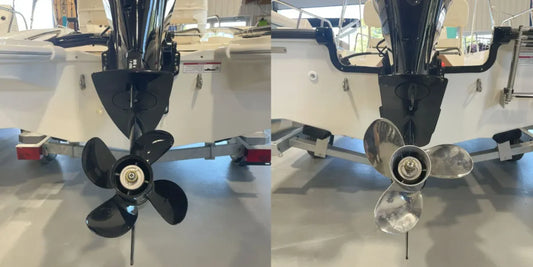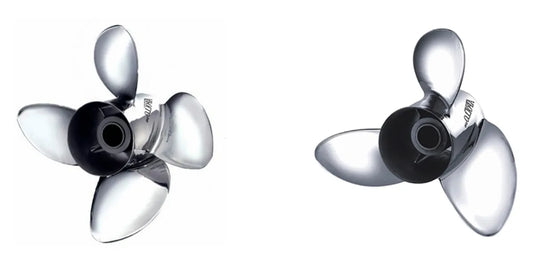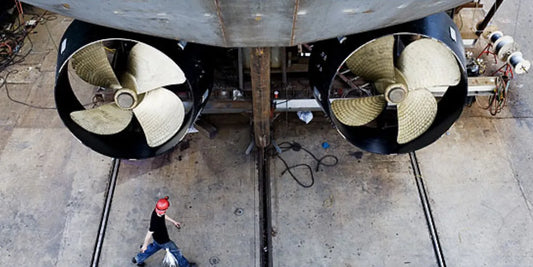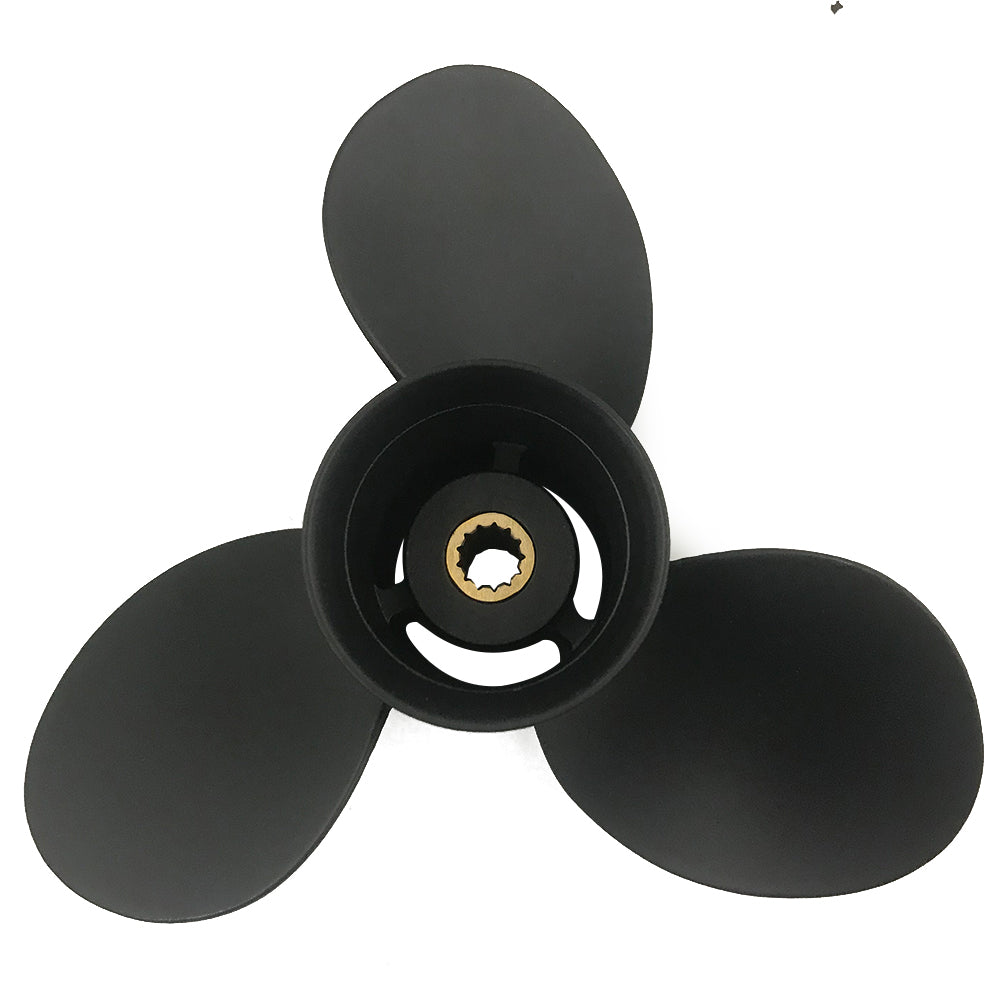The unsung hero of any smooth and efficient boating is the well-maintained boat propeller. Still, many a boater fails to appreciate that its correct operation significantly impacts performance, fuel consumption, and handling. Be it an intense fisher or a Saturday cruiser or in watersports, applying the basics of boat prop repair will always save you time, money, and bother while on the water. This guide will provide an in-depth look at some of the key techniques, tools, and common obstacles encountered during boat prop repair, so that you can have a say in your vessel's performance. It will guide you through everything, from identifying wear and damage to repairing it step by step, thereby helping you keep your prop working with maximum efficiency and making every journey a joy.
Understanding Boat Propellers

What Is a Boat Propeller?
A propeller is the main driving force of a vessel. Propeller construction typically comprises a hub with blades arranged in a manner that allows them to spin and generate thrust when driven by an engine. The propeller pushes water backward, resulting in a thrust directed forward due to linear motion obtained from rotational energy. Aluminum and stainless steel are the listed materials used in making propellers because they offer both durability and resistance to corrosion.
The number of blades, size and shape of the blades, and pitch—the distance a propeller moves in one revolution —are all aspects that affect boat performance. A higher pitch means a higher speed, but that requires higher engine power. However, with a lower pitch, acceleration is higher, albeit at the cost of a shorter top speed. To achieve optimal fuel efficiency, speed, and excellent handling, it is essential to be aware of these specifications and select the best propeller.
Differentiation Between Boat Propellers
Boat propellers are classified into a few types; they are treated diversely depending on individual demand and water conditions. Since the client knows the different types of propellers, it will be easier to opt for the appropriate one for his/her specific requirements:
Three-Blade Propeller: Three-blade propellers are the most common and versatile type, often seen on various boats. They tend to strike a balance between speed and fuel economy, making them ideal for recreational boaters. Therefore, it operates smoothly with minimal drag in open water.
Four-Blade Propellers: These propellers are required when an extra measure of stability, increased load capacity, and steady performance is needed. With four blades, there is improved acceleration and handling at mid-speed, making it perfect for waterskiing or handling heavy loads. They are also much less prone to ventilation and cavitation relative to their three-bladed counterparts.
Cupped Props: The cupped propellers have a lip or curve at the trailing edge of the blades. The design increases the grip on the water through which the propeller works, reducing slippage and increasing efficiency. These are great for high-speed situations or boats that operate in rough water conditions, providing steady performance without overloading the engine.
High-Skew Props: These types are made with blades that curve outward to extreme lengths. Since they reduce vibration and noise, they provide a very smooth ride. They are mainly used on boats that require a quieter operation, such as passenger vessels or luxury yachts.
Cleaver Props: Cleaver propellers are high-performance propellers suited mostly for racing or other high-speed applications. Cleaver propellers are thin and flat, with narrow leading edges, designed to minimize drag and achieve maximum speed. Their design prioritizes speed at the expense of maneuverability, which limits its application in most other recreational uses.
Weedless Propellers: Weedless propellers are considered for use in very vegetated areas. They have special contours that keep weeds and debris from clogging up the blades. They are more common on fishing boats or any watercraft near vegetation, sometimes water bodies, and offer a smooth performance at all times.
Determining the type of propeller to use is based on the size of the boat and the engine power, as well as the type of water it will be used in, considering the various water types it may encounter. Its choice plays a crucial role in efficiency, speed, and the overall boating experience.
The Importance of Propeller Repair
Regular maintenance and timely repair of boat propellers are essential to guarantee optimal performance, thereby protecting your vessel from long-term deterioration. A damaged or unbalanced propeller can result in low speed, high fuel consumption, and engine strain, requiring costly repairs. Chips, dents, or bent blades accumulate over time, often caused by underwater obstacles or general deterioration. Performance enhancement in the handling of the boat and smooth operation in various water conditions are achieved when the propeller is fine-tuned to its optimum condition.
On the other hand, propeller repairs can very much benefit safety. A damaged propeller can generate vibrations or an uneven thrust, resulting in inferior speed, making the vessel unstable and less controllable. Specified balancing technology is typically employed by technicians who take exact measurements of the propeller's details against what is required for the engine. Hence, timely attention to such details can aid in preserving the propeller's value in terms of life expectancy and also conserve the energy of time and money for enhancing performance, providing real pleasure while boating.
Common Issues with Outboard Propellers

Signs of Damage on Your Propeller
Knowing the signs of damage on your outboard propeller is crucial to keep your boat operating optimally and avoid costly repairs. Common signs of damage include noticeable dents, bends, or cracks on the blades, which may be caused by underwater collisions or debris. Unusual vibrations or noises while using the boat may be a sign of propeller imbalance or misalignment. If there is a loss in speed or a decline in fuel efficiency, the propeller may be showing signs of wear or damage and is unable to provide reliable thrust.
Another critical change to detect is the condition of the propeller hub. If the hub is damaged or deteriorated, it can slip, and power can be transmitted irregularly from the engine. Corrosion under excessive stress can damage wood in a short period, particularly in saltwater. With such an approach, regular inspection and maintenance can serve as a good plan to identify problems before they warrant repairs or replacement, thereby avoiding other issues and ensuring smoothness and safety during boating.
Common Causes of Propeller Damage
The damage to the propeller is a frequent concern, with diverse causal factors, and often leads to impaired performance and efficiency. One of the major causes is running into underwater objects, such as rocks, branches, or debris. Even slight bumps result in nicks, bends, or some form of deformation of the blades, which remove the hydrodynamic efficiencies. Cavitation is another issue that arises from the formation of bubbles around the propeller due to a rapid change in pressure. The bubbles then implode over time, corroding the blade surfaces, thus causing pitting and an inability to thrust poorly.
Improper sizing or installation can also cause damage. When a propeller is mismatched for the type of engine or vessel, undue stress may be exerted on the blades, resulting in accelerated wear. Corrosion caused by lack of maintenance and failure to remove marine growth can reduce performance or aggravate existing problems. Environmental factors can also contribute to corrosion, mainly when prolonged exposure to saltwater occurs, coupled with inadequate coating maintenance. By understanding the typical causes of corrosion and applying preventive measures, a boater can prolong the life of their propellers and help keep another object running at its optimal performance.
Impact of Damaged Propellers on Boat Performance
Damaged propellers significantly impair a boat's performance in terms of speed, fuel efficiency, and overall maneuverability. Studies show that even slight changes to the capture blade shape or structure can cause increased drag, resulting in the engine producing more power and consuming more fuel. This relates directly to relatively high operational costs and may potentially wear away the propulsion system even faster. On the other hand, uneven and bent blades create vibrations that reduce stability and passenger comfort, and can damage engine components later. Continued use of a damaged propeller would also restrict the boat's ability to reach peak speeds, whose performance is essential for racing or towing activities. Fixing issues early ensures the maximum upkeep of the propellers, which means enhanced efficiency of the boat and minimized cost for repairs farther down the road.
The Process of Boat Prop Repair

Tools Required for Propeller Repair
A boat propeller requires a repair process that combines conventional tools with specialized tools for accuracy and effectiveness. The following tools are essential in the process:
Propeller Wrench: Practically invented for the removal and tightening of propeller nuts, this wrench ensures small and reliable installations without ever damaging the hardware.
Rubber Mallet: Comes in quite handy when you have to give a few measured blows to free the propeller gently, as one thing is sure: a vibing blow will initiate cracks or dents in the propeller.
Prop Puller: This tool is necessary for removing propellers that have seized on the shaft, and its presence facilitates removal without damaging either the propeller or the shaft.
File or sandpaper: Filing or sanding is used to remove minor dings or nicks on the blades, restoring the aerodynamic quality of the propellers.
Dial Indicator: It is a precision tool for measuring blade alignment and detecting bends that ensure the propeller is balanced when in operation.
Reshaping or polishing the blade edges is a task typically performed by a grinder or polisher, especially after minor impact damage.
Epoxy or metal filler is used to repair any small cracks or gouges that compromise the structural integrity of the part, until it can be sanded and polished.
Workbench with Vise Attached: A work surface can hold the object and the vise securely, allowing delicate work to be performed.
Protective gear: Safety goggles, gloves, and protective aprons should be used while working with sharp tools or around chemical adhesives.
With these tools, propellers, whether made of aluminum, stainless steel, or composites, can be repaired by boaters and professional repair technicians. Good preparation and correct equipment will always further ensure that the repairs are good and last longer in the water.
The step-by-step guide to repairing a propeller
A damaged propeller can decrease its efficiency and reduce the life of your vessel's propulsion system. Follow these steps to achieve the best results:
Inspection of the Damage: Look for cracks, dents, bends, or other damage in the propeller. Tiny dents can be repaired, but any significant cracks or distortions must be addressed by a professional; otherwise, the propeller needs to be replaced. Mark the areas requiring repair.
Removal of the Propeller: Use a suitable wrench or propeller removal tool to remove the propeller from its shaft carefully. Ensure the propeller is securely fastened in a vice or clamp during this operation to prevent further damage. Respect the hardware, such as washers and nuts; store them carefully for reinstallation.
Straightening: If bent blades are included in the damage, use a specialized blade straightener or a mallet in conjunction with a sturdy vice. Gradually apply even pressure to bring the blade(s) back to their original shape, ensuring proper alignment. Do not overdo it! Over-correcting usually weakens the blade material.
Filling and Repairing: A minor dent or gouge? Fill it up with marine-grade epoxy or filler. Sand the surface lightly with abrasive paper to ensure the repair material adheres well. When it is smooth enough, sand it to match the contour of the propeller, ensuring that uneven surfaces do not disrupt the water flow during operation.
Balance the Propeller: If the propeller is unbalanced, it will vibrate and not perform well. Use your propeller balancing tool to ascertain the weights to be balanced on all blades—balance by sanding down with the sander, as needed.
Apply Protective Coating: Repaint the propeller with anti-corrosion and marine paint to re-establish its protection. Apply an even coat, allowing sufficient time for drying. This step will help prevent corrosion and physical damage from underwater debris.
Fit the Propeller: Secure the propeller onto the shaft, ensuring all components are securely fastened. Fully tighten the nut according to the manufacturer's recommendation, and then secure it with a cotter pin or alternative locking device for added security. Make sure that the propeller turns freely without any wobble.
8. Performance Test: Run a trial test under a controlled environment and study its performance before being finally set into operation. Check for abnormal vibration, unusual noise, or erratic behavior from the system that may indicate the need for further adjustments.
Properly repairing a propeller maintains the vessel's performance and safety. Incorporating these detailed steps into your maintenance routine ensures smooth, worry-free motoring.
When Do You Need Professional Services?
While in many instances common propeller problems can be tackled with some DIY, there are situations when a professional practitioner can best serve you. In the event you have significant damage—extensive cracks in the blades, severe bending, or missing blades, their repair will need to ensure structural integrity, and therefore, you should seek a qualified professional's help. Significant indications of inconsistent performance in your vessel may also be warning you of a deeper problem requiring professional diagnosis. These include indications such as a marked reduction in speed, an increase in fuel consumption, and difficulty maintaining balance.
An expert's opinion should be sought in cases where particular propellers are installed on high-performance boats or vessels to ensure the correct methods of measurement and adjustments are made to provide optimal performance. Modern workshops restore propellers to factory specifications using advanced tools, such as dynamic balancing machines and 3D scanning technologies, thereby enhancing efficiency and safety. If your operations regularly involve navigating through challenging environments, such as debris in the water or shallow waters, a professional inspection should be conducted periodically to detect latent damage that may escape the average eye during routine checks. At such times, prioritizing expert help will help to maximize the life of your propeller and avoid costly repairs in the long term.
Choosing the Right Materials for Propeller Repair

Stainless Steel vs. Aluminum Propellers
Understanding the key differences between stainless steel and aluminum when selecting a propeller can significantly impact performance and cost considerations. Aluminum propellers are often preferred by operators who are limited by budget, as they are lightweight and inexpensive to manufacture. They can be used for casual boating or in areas with no underwater hazards to worry about. However, they are more susceptible to damage and wear at speeds or torques, which reduces an aluminum propeller's durability in the long run.
Alternatively, stainless steel propellers offer the best strength, toughness, and performance, especially in heavy-duty uses. Flexing and cracking resistance allow them to maintain their proper form and operate efficiently while navigating through rough waters. Furthermore, stainless steel propellers typically offer better acceleration, top speed, and fuel economy, as they can maintain the thinness and accuracy of their blade designs more effectively. Although it is therefore at a higher price, the investment is generally worthwhile for regular or professional operators due to its extra durability and performance.
It depends mostly on your boating requirements and what you want to focus on. Aluminum propellers do almost everything well when in use from time to time and at light strain. To work tides and perform professionally most of the time, stainless-steel opportunities for wear and performance offer a good upgrade.
Advantages of Stainless Steel Propellers
There are several advantages to stainless steel propellers, making them popular among outboard professionals and frequent boaters. The simplest explanation would be durability. Stainless steel offers excellent corrosion resistance, making it ideal for both freshwater and saltwater settings. This resistance eventually allows a much longer life than aluminum, thus lessening propeller replacement and maintenance.
A further enhancement is that of performance. The thin steel blades tend to be more rigid, yet offer some level of flexibility during operation. They ensure that the speed-thrust remains optimum even during extreme conditions. For instance, higher speeds or sharp turns are handled better by stainless steel propellers, which ultimately result in better acceleration, providing a more responsive feel to the operator.
Furthermore, stainless steel propellers can withstand impacts more effectively than aluminum. Not indestructible, their strength reduces the damage caused by debris or shallow waters, thereby saving on repair costs. Their heavier weight also ensures smooth operation by minimizing vibration and noise during use.
Although stainless steel propellers are slightly more expensive, their durability and performance ultimately provide better value in the long run. For those who value reliability, efficiency, and incessant good performance, this kind of propeller is an excellent investment.
How to Choose a New Propeller for Your Boat
A proper propeller needs to be selected, taking several factors into account, thus enabling the boat to perform at its best possible level efficiently. Acquaint yourself with the correct diameter and the pitch for your boat. Diameter is defined as the size of the circle that the propeller sweeps as it spins; pitch is the distance that the propeller moves forward in one complete revolution. A low pitch acts as a good accelerator, while a high pitch is favorable for top speed, and the decision depends on what you intend to do in your particular boating application.
One other main consideration is the number of blades. Three-blade propellers are mostly employed since they provide additional speed and efficiency in most conditions; four-blade propellers, however, offer more acceleration and smoother operation, making them suitable for heavy-duty applications or watersports. The choice of material is also essential, as aluminum propellers are economical and ideal for general applications, while stainless steel ones provide superior durability and better performance under harsh circumstances.
Check the engine specifications of your boat, along with its intended use. Parameters such as the horsepower of the engine, the weight under operation, and the typical water conditions must also affect the choice. For barely anything to save on fuel or meet specific requirements, it might be worthwhile to check with a marine specialist or try out a few propellers. Making these considerations will help you choose a propeller that provides good handling, speed, and durability for your boat.
Marine Propeller Sales and Upgrades

Where to Buy Quality Propellers
When it comes to purchasing quality marine propellers, my foremost consideration is a trusted source that specializes in marine equipment and is deemed highly reliable. I like to start by visiting local marine supply shops, as they usually offer genuine advice and intricate product knowledge. They also assess particular needs with respect to engine compatibility, type of boat, and performance preferences, thereby ensuring I am making a very well-informed decision.
Also beneficial are online outlets stocked exclusively with marine products, along with the added convenience of shopping at odd hours and, of course, much wider selections. Websites such as West Marine, Propeller Depot, and Boat Propellers Warehouse boast hundreds of items in their inventory, detailed specifications, and reviews from other boat owners. The best sites might even provide virtual assistance or a customer support chat option to help determine the appropriate fit for the propellers of my vessel.
In my opinion, there is also another excellent choice for me when buying genuine propellers made for a curated-specific engine brand: certified dealerships. These will stand behind the product for authentic spp, with a warranty to provide a soothing promise. I have limited my research to these channels, consulting experts as necessary, to ensure that I can purchase a propeller that competes in quality with performance and durability.
Renovate Your Propeller for Comfort and Performance
This text explains that my propeller upgrade can significantly enhance vessel performance, with a special emphasis on how we learn about the specific needs of a boat and how propellers are designed to meet them accordingly. I thus first study how my boat performs right now-will it be saved for a better fuel mileage, a higher speed, or a series of handling, while knowing these requirements will allow me to choose the proper material, pitch, and blade count, since it is known that all can affect performance in quite different ways. For instance, when I am carrying heavy loads frequently or for a considerable amount of time on rough waters, I want a stainless steel propeller that is very slow in pitch, providing enough torque and being somewhat durable. On the contrary, for speed and maneuverability, an aluminum propeller with a considerable amount of pitch is preferred.
Another essential step to consider is that the new propeller matches my engine power and operating range. Factory specifications or recommendations from a local expert sitting on the shelf will help me find a propeller that maintains my engine within the recommended RPM range for optimal efficiency. Again, shifting to a four-blade propeller design, perhaps for smoother acceleration, should bring that setup closer to the specific performance characteristics I have in mind. The sources of such information can be forums, comparison tools, or agencies or dealers that offer trial policies to test your options, allowing you to make a confident purchase decision.
Lastly, I learned that maintaining my propeller upgrade is crucial to fully take advantage of its benefits. By keeping a regular watch for damage, cleaning it when buildups occur, and selecting parts to replace as needed, my vessel should maintain excellent performance. Given that I have considered my performance targets, researched, and invested in ongoing maintenance, I extract maximum advantage from my propeller upgrade, and as a result, I enjoy boating more pleasantly and efficiently.
Maintaining Your New Propeller
To maintain the new propeller and enhance its performance, regular inspection is needed. I want to ensure that I check for damages such as cracks, dents, or bent blades, as these can reduce efficiency and fuel economy. For any significant problems, I'll consider an immediate fix or replacement of the propeller if repair is not an option. Being vigilant at all times definitely helps avoid sudden incidents while enjoying a day out.
In addition, proper cleaning of the propeller should be focused on to avoid the formation of marine growth, debris, or corrosion. I intend to use cleaning solutions and tools that are compatible with my propeller material selection, whether stainless steel or aluminum, thereby minimizing potential harm. This will prevent corrosion on the propeller surface and maintain smooth activities and optimal performance.
The other thing I realize is the importance of proper storage and handling of my propeller. During non-use or off-season periods, I will ensure that the prop is stored in a dry and secure place to preserve it from any unnecessary wear. Such matches with continuous maintenance, along with my dedication to learning more about the upkeep requirements of my propeller, shall aid in maximizing its lifespan, thus enabling me to have an easy boating experience.
Reference Sources
-
How to Master the Art of Boat Propeller Repair - Buy Propeller
Provides a step-by-step guide on assessing damage, straightening bent blades, and more. -
Damaged Boat Prop 101 - Yamaha Outboards
Offers advice on when to repair or replace a propeller based on cost and damage severity. -
Fixing Boat Propeller Problems - BoatUS
Explains how propeller condition affects propulsion, fuel efficiency, and engine longevity, with tips for diagnosing and fixing issues. -
DIY: Boat Propeller Repairs - Gold Eagle Co.
Shares practical DIY tips for repairing boat propellers, including proper mounting and access techniques.
Frequently Asked Questions (FAQs)
What Are Some Common Signs Indicating That My Boat Propeller Needs Repair?
Common signs that your boat's propeller needs repair include abnormal vibrations during operation, reduced performance, and visible damage to the propeller blades. If you notice your boat being towed back to shore repeatedly, or if your propeller seems to be easily damaged, it is best to have it checked out by a professional without delay. Alternatively, if a strange sound is coming from the prop or you begin to notice small chips and dents on the stainless steel prop, these may be signs of minor damage. Keeping up with regular maintenance can prevent any catastrophic damage and keep the marine propeller in perfect working condition.
How Much Does It Typically Cost to Repair Boat Propellers?
Buying a new propeller can be expensive, and so can repairing it. The prices depend on the extent of damage and the type of property you have. For example, welding or reshaping the edges of the blade may be relatively expensive, while larger damages would necessitate a complete overhaul or replacement, which, of course, would be pricier. Another thing to note these days: stainless steel props cost more than aluminum ones, so the material cost of your repair will be higher. So, if you want to be cost-conscious during emergencies, always think about carrying a spare prop.
Can an Aluminum Prop Be Repaired?
Yes, aluminum prop repairs can often be performed when damage is light. Repairs can commonly include straightening a bent blade and welding a crack. That said, aluminum props may be more prone to damage than stainless steel types and may not always be worth repairing if they are significantly damaged. Sometimes, it may be cheaper to buy a used prop or invest in a new one. Damage assessment is crucial in determining whether to repair or replace it.
What Should I Consider When Buying a New Propeller?
A propeller has many key characteristics to consider when buying a new one for your outboard motor. Selecting the right propeller can significantly enhance your boat's thrust and fuel efficiency. There is also the choice between a stainless steel and an aluminum prop that must be considered for your boat's specific needs. It is also beneficial to check the OEM specifications for your motor and verify if the propeller in question matches the OEM description. Consult with a marine specialist when you are unsure about which propeller to use for your setup.
Can I Do My Own Repairs on a Boat Propeller?
Some minor repairs can be attempted with the help of the Lake, including changing a cotter pin or performing some simple maintenance. However, if the repair is complex, it is safer to take it to a repair shop instead of attempting to fix it yourself. An improper fix will only spell significant damage while the repair is still underway. The repair of substantial issues, such as welding cracked blades or balancing the propeller, definitely requires specialized services. The prop service is crucial for the safety of the boat and for optimal boat performance.
How Do I Prevent Damage to My Boat Propeller?
A boat propeller is a very delicate instrument, and to prevent it from getting damaged, you should always stay aware of your operating environment. Refrain from running aground in shallow waters and be mindful of submerged objects. Check your prop regularly to ensure it has not suffered wear and tear and is properly aligned with the prop shaft. Carrying a spare one will at least lessen the possibility of being stranded due to a failed prop. Lastly, you may want to consider applying marine-grade anti-fouling paint to prevent corrosion and growth that could impair your prop's performance.
